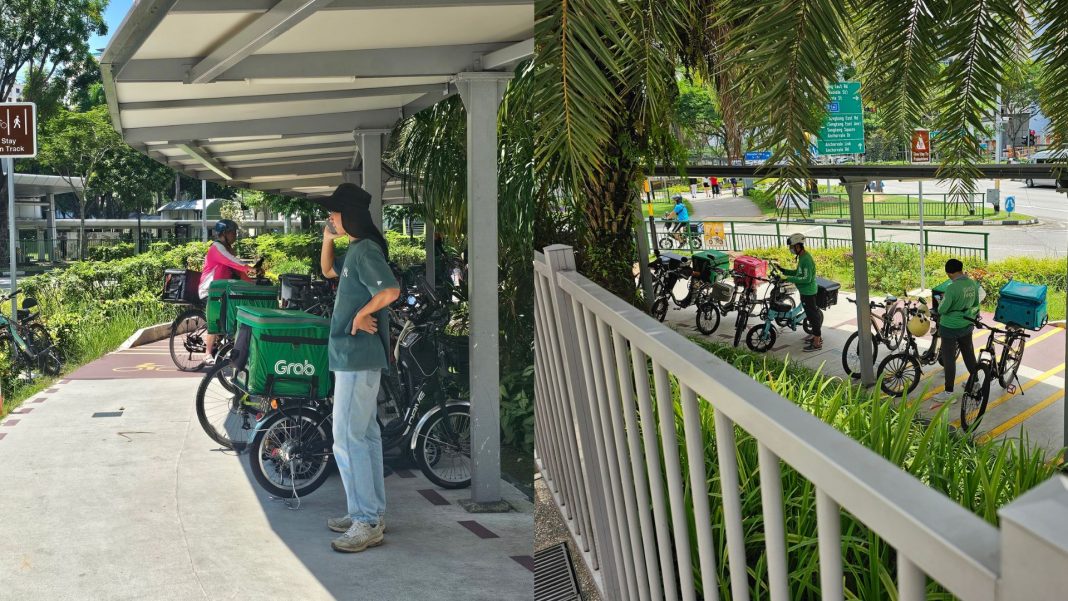SINGAPORE: At first glance, Singapore’s islandwide cycling path network was initially designed to ease congestion, promote active mobility, and support the nation’s “city in nature” ambitions. But on the ground, some residents say the reality is far messier.
At a busy intersection between Sengkang General Hospital and the MRT/bus interchange, commuters are grappling with a recurring challenge — food delivery riders parking their bicycles across pedestrian walkways, blocking access and pushing foot traffic into cycling lanes, a move some call not just inconvenient, but outright dangerous.
Bottlenecks on the sidewalk
“Their behaviour is so ‘selfish and inconsiderate.'” said W Jia Man, a resident who posted about the issue on a complaints forum on Facebook. “These riders park their bikes horizontally, taking up the entire pedestrian path. People have no choice but to walk on the cycling path.”
The problem intensifies on rainy days, when sheltered paths become even more vital, especially for the elderly, hospital patients, or families with young children. Instead, they are forced to navigate exposed bike lanes, often while cyclists speed past.
“Even if it’s raining, riders should park at the side,” Jia Man added, “not block the entire sheltered path.”
The pressure on delivery riders
Delivery riders — especially those with Grab, Deliveroo, and foodpanda — have become essential to Singapore’s urban rhythm. But their growing presence has raised fresh questions about how gig work intersects with public space.
While residents like Jia Man point to inconsiderate behaviour, others acknowledge that riders face immense pressure: tight delivery windows, algorithm-based ratings, and limited rest areas.
“You can say delivery work is tough and tiring,” Jia Man wrote, “but that’s no excuse for that behaviour.”
In high-traffic areas like Sengkang, the issue has become systemic, not just behavioural. At any hour, visitors will find parked bicycles, e-scooters, and even motorbikes clustered around MRT exits — some double-parked, others abandoned in pedestrian zones.
To fine or not to fine?
Under the Active Mobility Act, the Land Transport Authority (LTA) can issue fines for improper parking and unsafe riding. While intended as a deterrent, such penalties are increasingly controversial.
Many riders operate as gig workers. A single fine, sometimes issued for a short stop to drop off food, can wipe out a day’s earnings. For some, it’s the difference between bringing home groceries or going without.
This dilemma raises a difficult question: How do we enforce public order without disproportionately punishing those at the bottom of the economic chain?
Towards shared responsibility
Potentially through a mix of enforcement and empathy, including:
-
More designated parking bays near MRT exits, hospitals, and food clusters
-
App-based nudges for riders to use proper parking areas before order completion
-
Public awareness campaigns for both riders and pedestrians
Cycling paths and walkways can only work if they’re designed with all users in mind — and if those users see themselves as part of a shared space.
Can the paths truly be shared?
The tensions in Sengkang reflect a broader national test: Can Singapore build a mobility ecosystem that works for pedestrians, cyclists, and riders alike? One that is not only fast and efficient, but fair and safe?
If left unresolved, these daily frustrations may quietly erode public support for active mobility initiatives. Because when walkways become obstacle courses, and bike lanes feel like battlegrounds, the shared dream of a sustainable, walkable city starts to break down.
As more voices speak up, the path forward may depend less on penalties and more on empathy, design, and a renewed culture of shared space.

